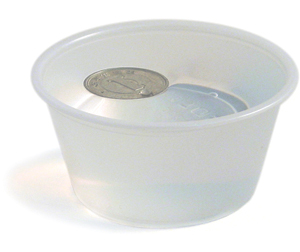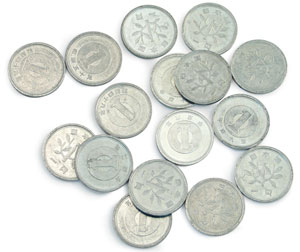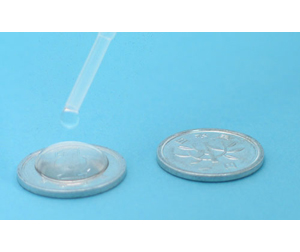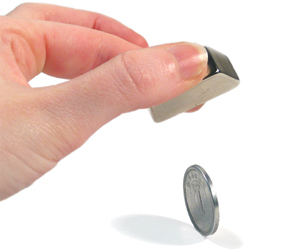Who knew that a single coin could be used for so many classroom science activities! You can demonstrate concepts such as surface tension, buoyancy, and even eddy currents with Japanese yen coins!
Surface Tension: Even though aluminum has a density of 2.7 gm/cm3, and the density of water is 1 g/cm3, aluminum yen coins can float on the surface of the water!
Surface tension is a physical property of water. It is caused by cohesion, which is the attraction of like molecules. Water molecules are made up of two hydrogen atoms and one oxygen atom. The “stickiness” of water is caused by hydrogen bonding. This hydrogen bonding pulls the water molecules towards one another and forms a sort of “skin” on the surface of the water.
Japanese Yen Coins Experiment 1:
 Using a bent paper clip or a plastic fork, gently lower the flat side of the coin onto the surface of a pan or cup of water and remove the clip or fork. The coin should rest on the surface of the water. Plastic cups, glass bowls or baking dishes
Using a bent paper clip or a plastic fork, gently lower the flat side of the coin onto the surface of a pan or cup of water and remove the clip or fork. The coin should rest on the surface of the water. Plastic cups, glass bowls or baking dishes  with clear sides will make it easy to see the effects of surface tension. The coin will actually slightly depress the surface of the water and can easily be viewed through the side of the dish or pan.
with clear sides will make it easy to see the effects of surface tension. The coin will actually slightly depress the surface of the water and can easily be viewed through the side of the dish or pan.
Adding more than one coin to the pan will result in a cluster of coins forming. Since each coin depresses the surface of the water, they will tend to slowly float together and form a regular, crystalline structure. (Imagine bowling balls on a stretched bed sheet – they will slowly roll towards each other to form the most stable structure.)
Adding a few drops of soap, such as dish detergent, will break up the surface tension of the water and cause the coins to sink.
Japanese Yen Coins Experiment 2:
Another great surface tension experiment you can conduct with your students is to have them initially predict the number of drops of water they can fit on the face of the yen. Then, using a pipet, have  students drop water, one drop at a time, onto the face of the coin. They will be amazed at how many drops this small coin will hold. This activity is perfect for discussing variables that could change the results of the experiment as a result of the experimenter’s manipulation (independent variables) . Students can brainstorm reasons that some coins held more drops of water than another. Examples include the side of the coin that is used, how worn the coin is, and how high above the coin the water is dropped from the pipet. Controlling as many of these variables as possible, gives the most accurate results.
students drop water, one drop at a time, onto the face of the coin. They will be amazed at how many drops this small coin will hold. This activity is perfect for discussing variables that could change the results of the experiment as a result of the experimenter’s manipulation (independent variables) . Students can brainstorm reasons that some coins held more drops of water than another. Examples include the side of the coin that is used, how worn the coin is, and how high above the coin the water is dropped from the pipet. Controlling as many of these variables as possible, gives the most accurate results.
Other Demonstrations with Japanese Yen Coins:
Buoyancy vs. Surface Tension: A charged rod will have different effects on floating objects, depending upon whether the object is floating due to surface tension or buoyancy (displaced water). A buoyant object will be attracted to a charged rod, while an object resting on the surface of the water will be repelled. Try charging a rod or piece of PVC pipe and bring it near to a floating aluminum coin – the coin will be repelled. To demonstrate a buoyant object being attracted to a charged rod, make a small boat out of aluminum foil and float it in the same pan as the coins. This boat will be attracted to a charged rod.
Eddy Currents: For this demonstration, you will need a strong magnet, such as one of Educational Innovations’ neodymium magnets. First, demonstrate that the yen coin is not  magnetic, by trying to pick it up or stick it to the magnet. Next, set the coin on a flat surface, so that it balances upright on its edge. Very quickly move the magnet back and forth over the top of the coin without touching it. The rapid movement of the magnet will induce an eddy current, which creates a temporary magnetic field in the coin. The magnetic field in the coin is attracted to the moving magnet above, causing the coin to move.
magnetic, by trying to pick it up or stick it to the magnet. Next, set the coin on a flat surface, so that it balances upright on its edge. Very quickly move the magnet back and forth over the top of the coin without touching it. The rapid movement of the magnet will induce an eddy current, which creates a temporary magnetic field in the coin. The magnetic field in the coin is attracted to the moving magnet above, causing the coin to move.
There are so many uses for this small aluminum coin in every science classroom. You can get yours at Educational Innovations for only $7.95 for a package of 50 yen coins!

this was so helpful, thank you